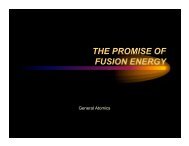Workbook: Fusion Natures Fundamental Energy Source - General ...
Workbook: Fusion Natures Fundamental Energy Source - General ...
Workbook: Fusion Natures Fundamental Energy Source - General ...
Create successful ePaper yourself
Turn your PDF publications into a flip-book with our unique Google optimized e-Paper software.
<strong>Fusion</strong> <strong>Workbook</strong><br />
What is the World Doing to Meet<br />
the <strong>Fusion</strong> Challenge?<br />
Meeting the challenge of fusion has<br />
been the task of over a dozen tokamak<br />
research facilities worldwide, including<br />
the JT-60U in Japan, the ASDEX-U in<br />
Germany, T-15 in Russia, Tore Supra<br />
in France, and the Frascati-U in Italy.<br />
The Joint European Torus (JET), located<br />
in England, is the largest operating<br />
tokamak and produced almost 2 million<br />
watts of power in 1991 using a 90/10<br />
DT fuel mixture. TFTR (Tokamak <strong>Fusion</strong><br />
Test Reactor) in Princeton, New<br />
Jersey, DIII–D, at <strong>General</strong> Atomics in<br />
San Diego (Fig. 12), and Alcator C-Mod<br />
in Cambridge, Massachusetts are the<br />
currently operating fusion research<br />
laboratories in the United States.<br />
In November 1994 the TFTR used a<br />
50/50 mixture of DT fuel to produce<br />
more than ten million watts of power.<br />
More recently, the DIII–D device has<br />
shown that a much smaller device may<br />
be capable of achieving similar results.<br />
Many other promising fusion concepts<br />
are being studied in universities and<br />
research laboratories around the world.<br />
<strong>Fusion</strong>’s Future: Is it in the Stars?<br />
Progress towards the development of a<br />
working fusion device has been steady<br />
and impressive, but there is still a long<br />
way to go (Fig. 14). Scientists have successfully<br />
created the 100 million degree<br />
plasmas required for fusion, and are on<br />
the verge of exceeding plasma breakeven<br />
— the condition at which more<br />
power is produced by fusion than goes<br />
into heating the plasma.<br />
B<br />
a<br />
c<br />
k<br />
g<br />
r<br />
o<br />
u<br />
n<br />
d<br />
I<br />
n<br />
f<br />
o<br />
r<br />
m<br />
a<br />
t<br />
i<br />
o<br />
n<br />
<strong>Fusion</strong> Power<br />
MW th<br />
kW th<br />
W th<br />
1,000<br />
100<br />
10<br />
1000<br />
100<br />
10<br />
1000<br />
100<br />
10<br />
PLT<br />
PDX<br />
TFTR<br />
DIII<br />
TFTR / JET<br />
TFTR<br />
JET<br />
ALCATOR C<br />
DIII-D<br />
JT–60U<br />
JET / TFTR<br />
DIII-D<br />
ITER<br />
Achieved (DD)<br />
Achieved (DT)<br />
Projected (DT)<br />
1<br />
1970 1980 1990 2000 2010<br />
PLT<br />
PDX<br />
JET<br />
DIII & DIII-D<br />
Princeton Large Tokamak<br />
Princeton Divertor Experiment<br />
Joint European Torus<br />
<strong>General</strong> Atomics Tokamak Experiments<br />
TFTR<br />
ALCATOR C<br />
ITER<br />
JT–60U<br />
Princeton Plasma Physics Laboratory<br />
Massachusetts Institute of Technology<br />
International Thermonuclear Experimental Reactor<br />
Japanese Tokamak Experiment<br />
Fig. 14 - <strong>Fusion</strong> power output of major research facilities<br />
At the present<br />
rate of success,<br />
the world fusion<br />
program should<br />
reach break even<br />
before the end of<br />
the century and<br />
through international<br />
collaboration,<br />
produce a<br />
burning plasma<br />
early in the next<br />
century. Power<br />
plants based on<br />
these ongoing<br />
experiments are<br />
expected just<br />
http://<strong>Fusion</strong>Ed.gat.com<br />
11<br />
QTYUIOP




